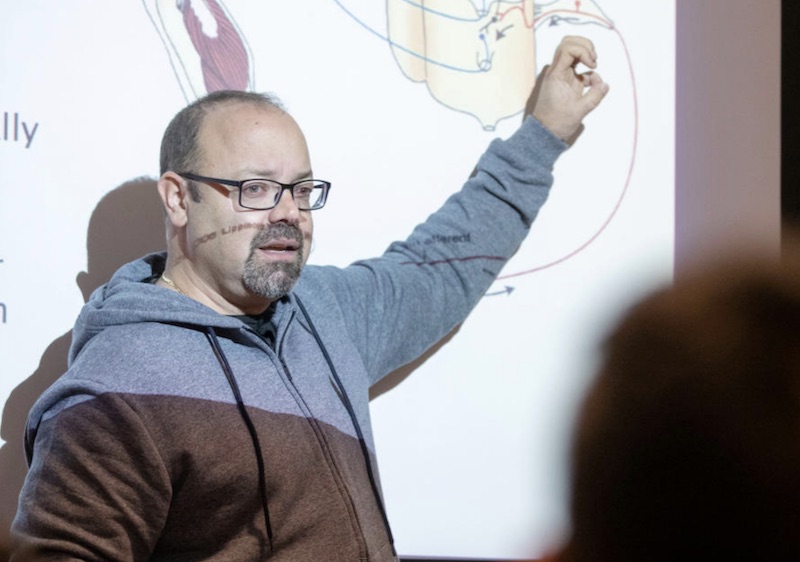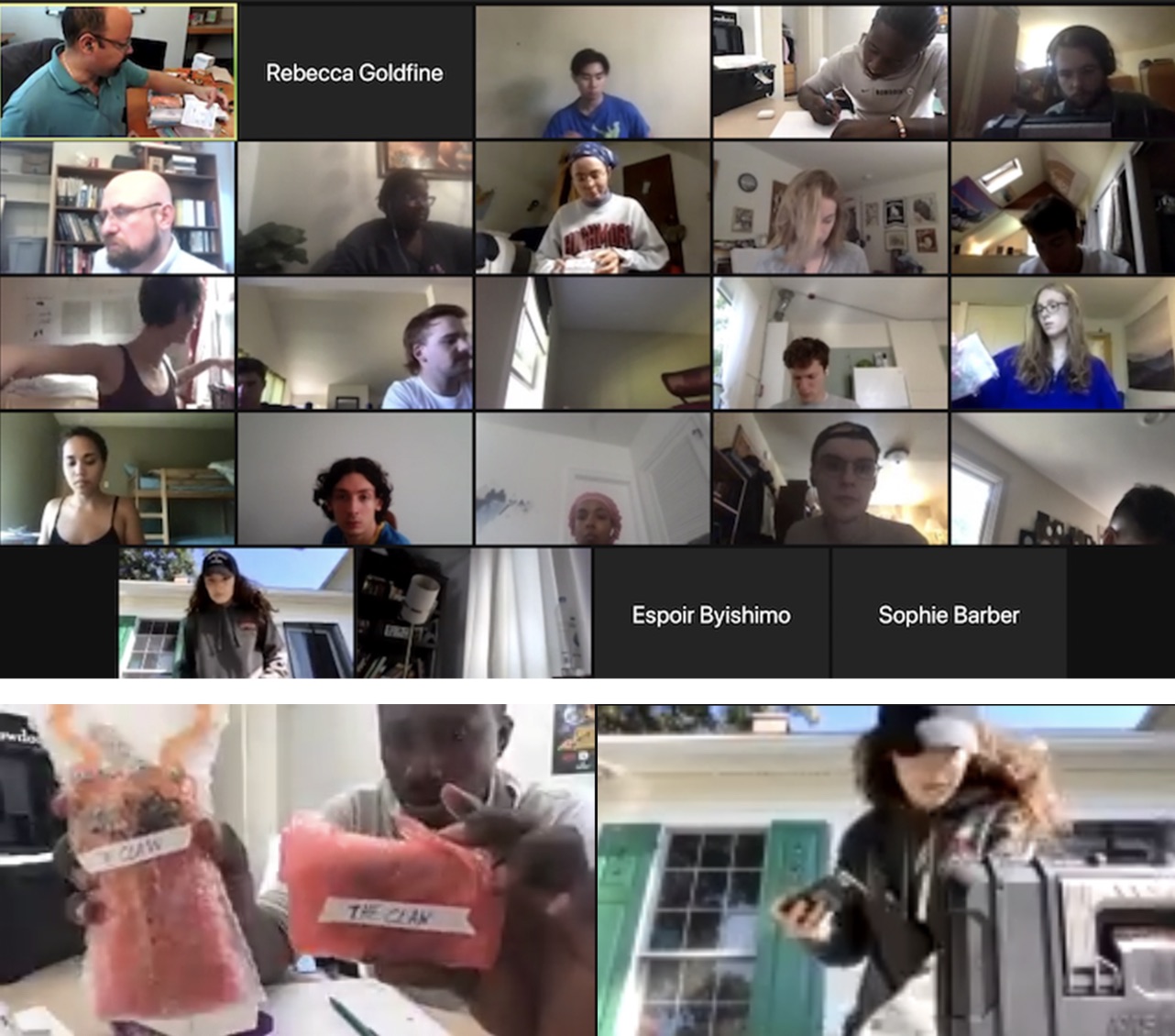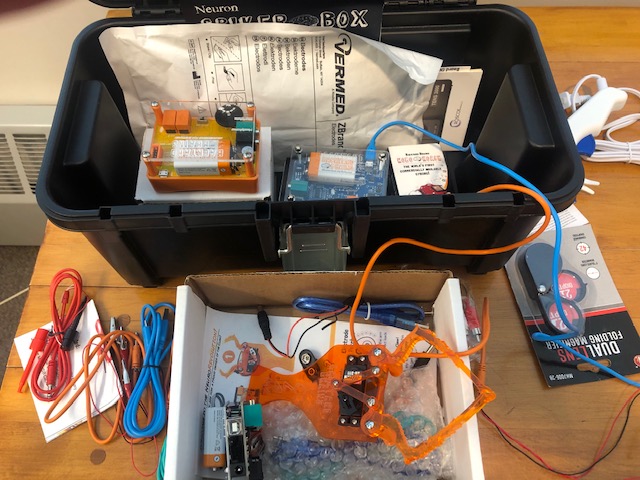Online Teaching: Neuroscience at Home
By Rebecca Goldfine
In one of the first labs for Díaz-Ríos's fall semester class Brains in Motion: Exploring the Science between Mind and Body, students participated in a quick demonstration at home.
After attaching electrodes to their arms, they clipped themselves to something ominously called "the claw," a small orange gadget with two long pincers.
Then they flexed their fists up and down, bending at the wrist. As they did, the claws opened and shut. Lots of student faces, in their small Zoom squares, expressed delight
"This is an example—which we will talk about later in class—of prosthetics," explained Díaz-Ríos, who teaches neuroscience. "You're using the contractions of your arm, which are controlled by your brain signals, to drive a robotic interface."
Students in the Brains in Motion class will watch a July 2 conference on Black Lives Matter and neuroscience. The conference focused on the challenges neuroscientists of color face within the field, and provided guidance on how the neuroscience community can leverage this moment to influence change. "We will discuss it and have an engaging conversation. We try to keep up with the current times and current events," Professor Manuel Díaz-Ríos said.
This semester, students in this non-major science course are exploring the brain and nervous system and conducting at least five labs. "The class looks at how our body lets us know what is going on in our inner and outer worlds, and how we engage with it in order to survive or have a wonderful experience with what surrounds us," Díaz-Ríos said.
The class is able to do this—no matter their location or circumstance—because early in the semester Bowdoin sent each of the twenty-four students a kit assembled by a company called Backyard Brains. (These neuroscience kits are just one of many that Bowdoin science departments sent to students' residences so they can do labs at home.)
Backyard Brains, a Michigan-based business founded by scientists, produces inexpensive but sophisticated science equipment for students in every grade, from kindergarten to college.
Díaz-Ríos has been a longtime user of the equipment and a collaborator with the company. (He's currently co-writing a paper with the company leaders for the Journal of Undergraduate Neuroscience Education about online laboratory learning.)
The Backyard Brain toolboxes for Bowdoin, which cost about $1,500 each, include signal amplifiers, cables, dissecting tools, reflex hammers, and surface electrodes. This box is just one of many scientific kits that professors in Bowdoin's chemistry, biology, anthropology, earth and oceanographic science, and psychology departments mailed to students studying remotely this semester.

Díaz-Ríos said his DIY kits are designed with creativity in mind. "What I like is that the students can let their imaginations fly with them," he said. "This is what we call open-ended science, as opposed to typical classroom experiences when you already know what is going to happen in the lab."
Throughout the semester, the students will investigate other topics such as the stimulants that affect heart rates and brain waves; whether they can detect lies; and how anxiety, stress, and extreme temperatures impact the body and mind.

Class participant KJ Matte ’21 said the class has been nothing short of positive for him so far. "From the guest lectures to the Backyard Brains' toolkit and experiments, I have learned more about neuroscience than I ever thought I would," he said. "I look forward to class because Professor Díaz-Ríos explains concepts coherently—and quite frankly, the class is not boring!"
Radu Stochita ’21, who is studying remotely from Romania, said performing neuroscience experiments at home has been one of his favorite Friday night activities for the past six weeks. "I must say that not only I, but all my friends, parents, and everyone I have shown the toolbox, have been impressed. Coming from an educational system in which experiments in science were scarce, almost non-existent, having the chance to learn about the brain by performing some small analyses on myself seems surreal," he said. "Definitely it could be way more in-depth if we were present in a laboratory, but we must adapt and see how we can maximize the tools we have at our disposal."
While professor Manolo Díaz-Ríos is ensuring his students have a hands-on means of learning about the nervous system—one that is also "inclusive and rewarding, and as fun as possible"—he is also sensitive to the challenges that online learning poses for students.
In all of his classes, he insists on taking a ten-minute break in the middle of the session to prevent screen fatigue. And he's flexible with his office hours so that students living in different time zones can get a chance to connect with him.
"We have to be creative and come up with ways to engage students and make them feel we’re going above and beyond for them," he said. "You have to come up with ways to increase engagement."


